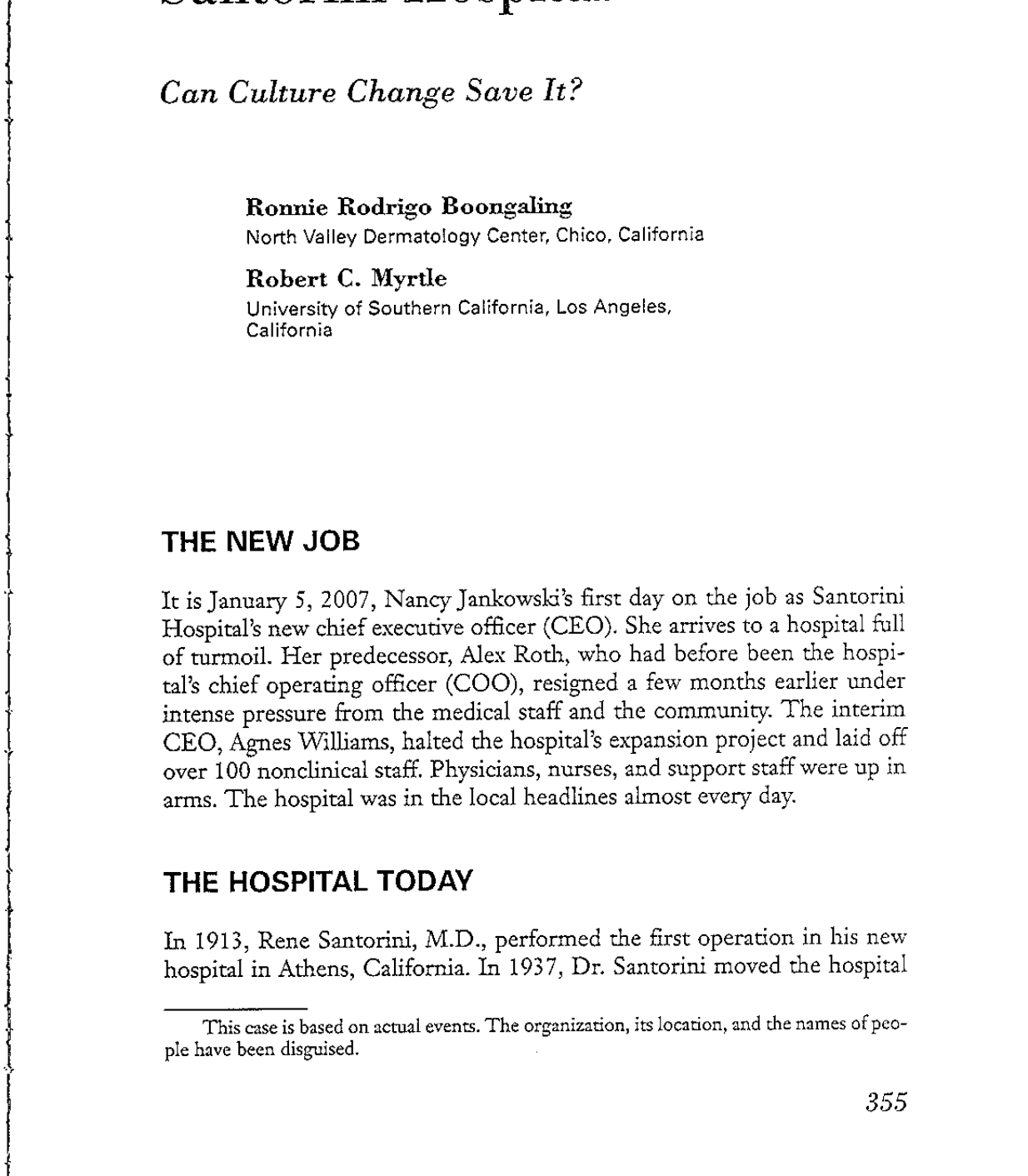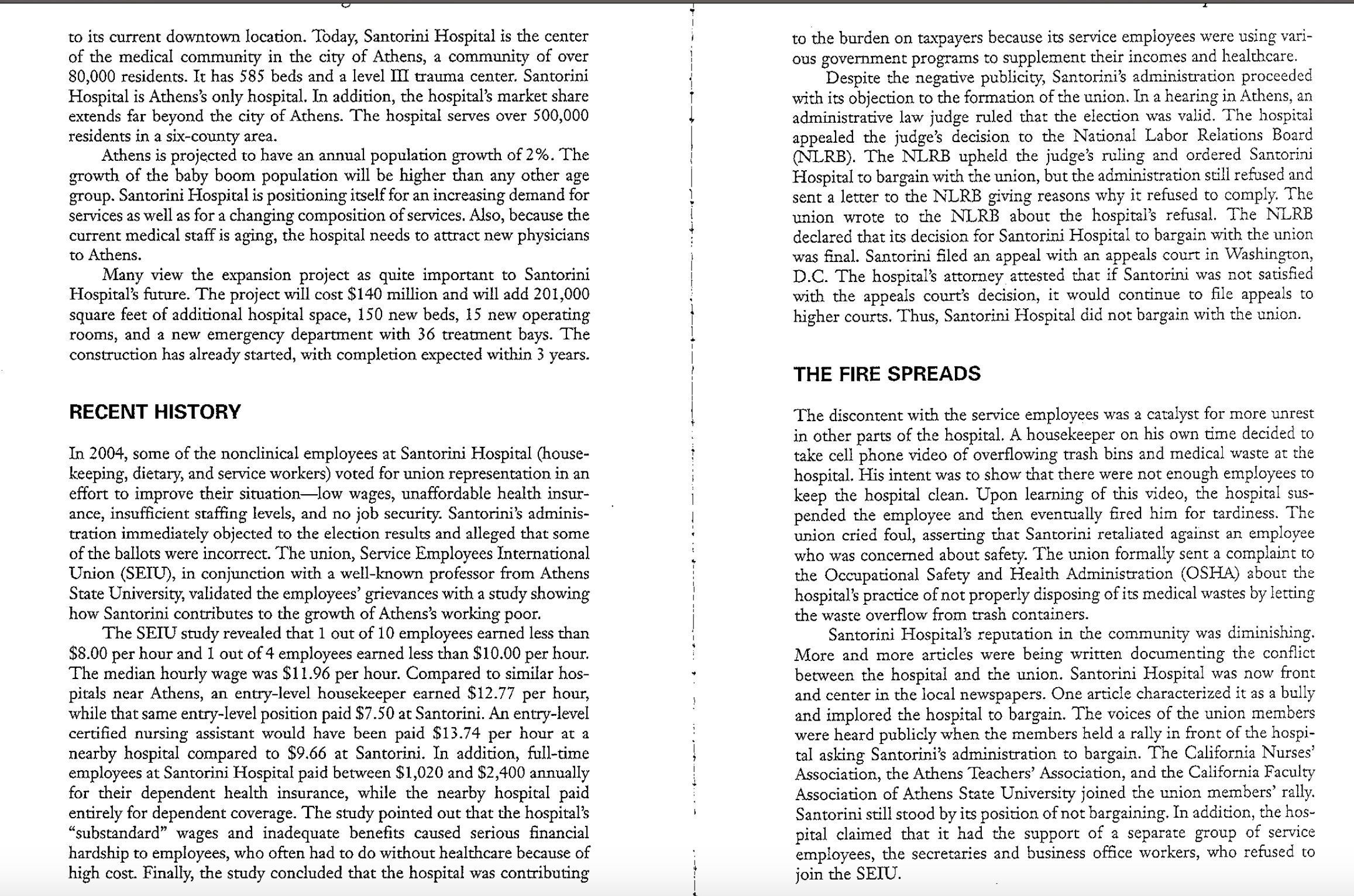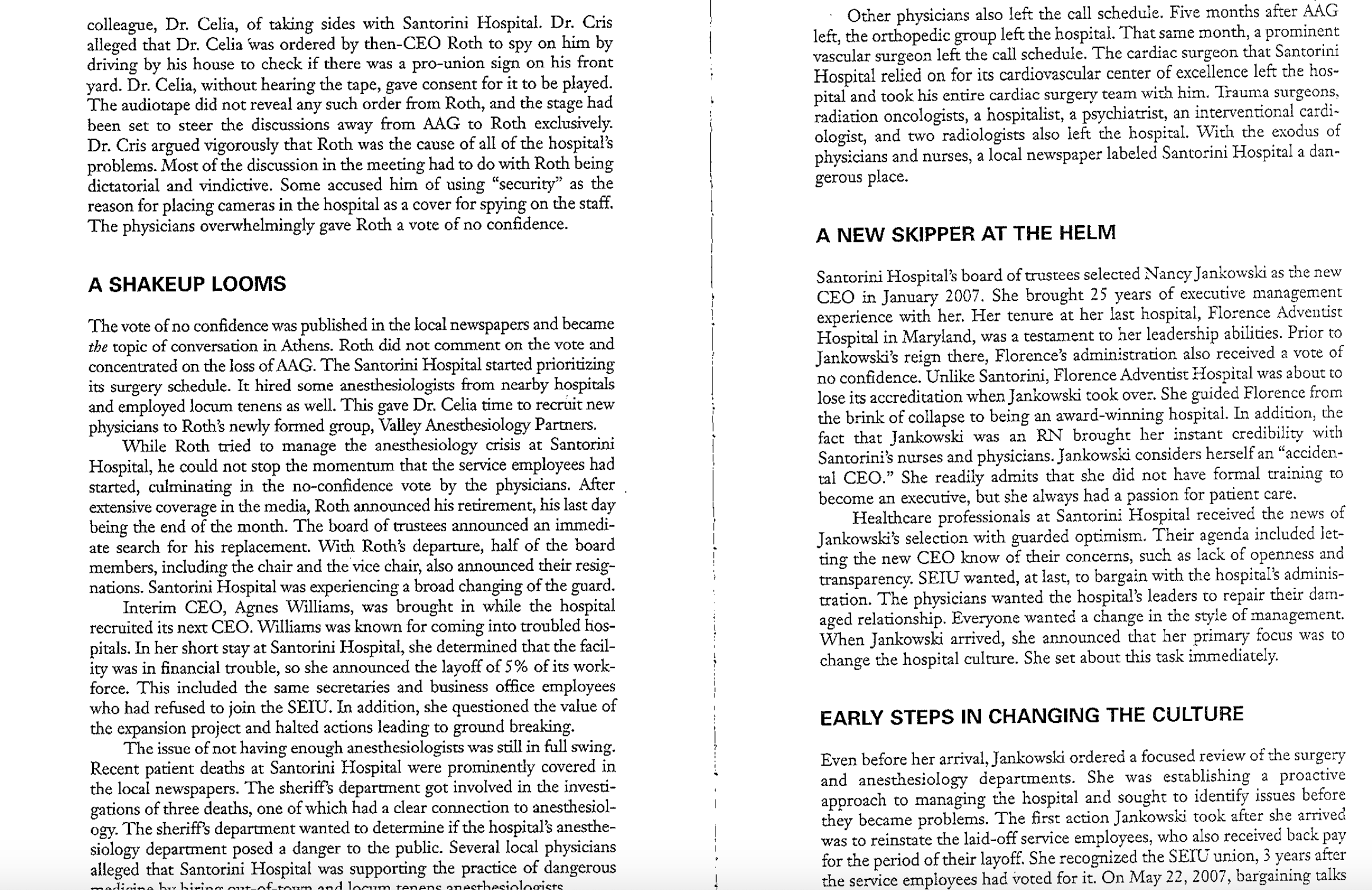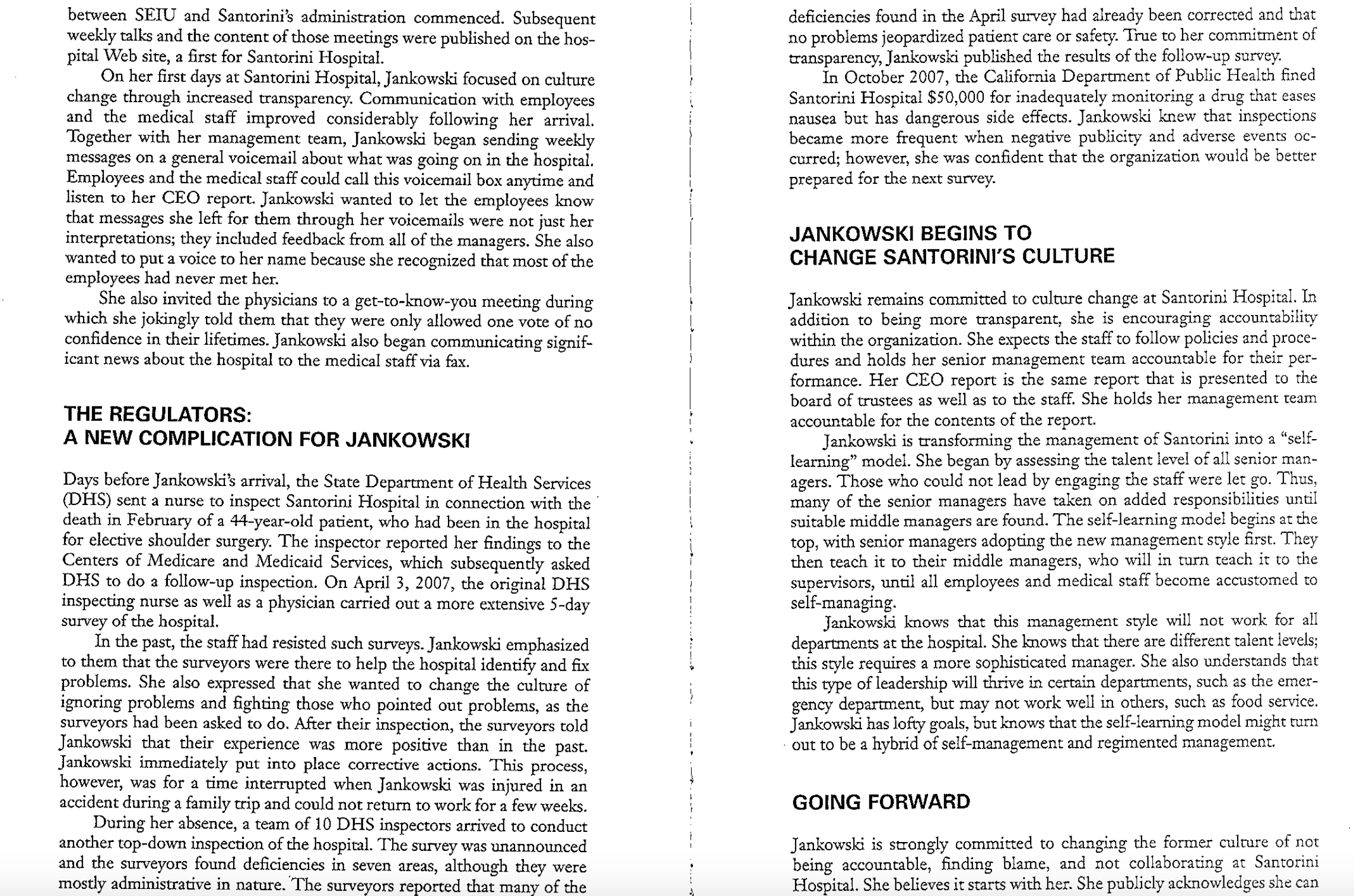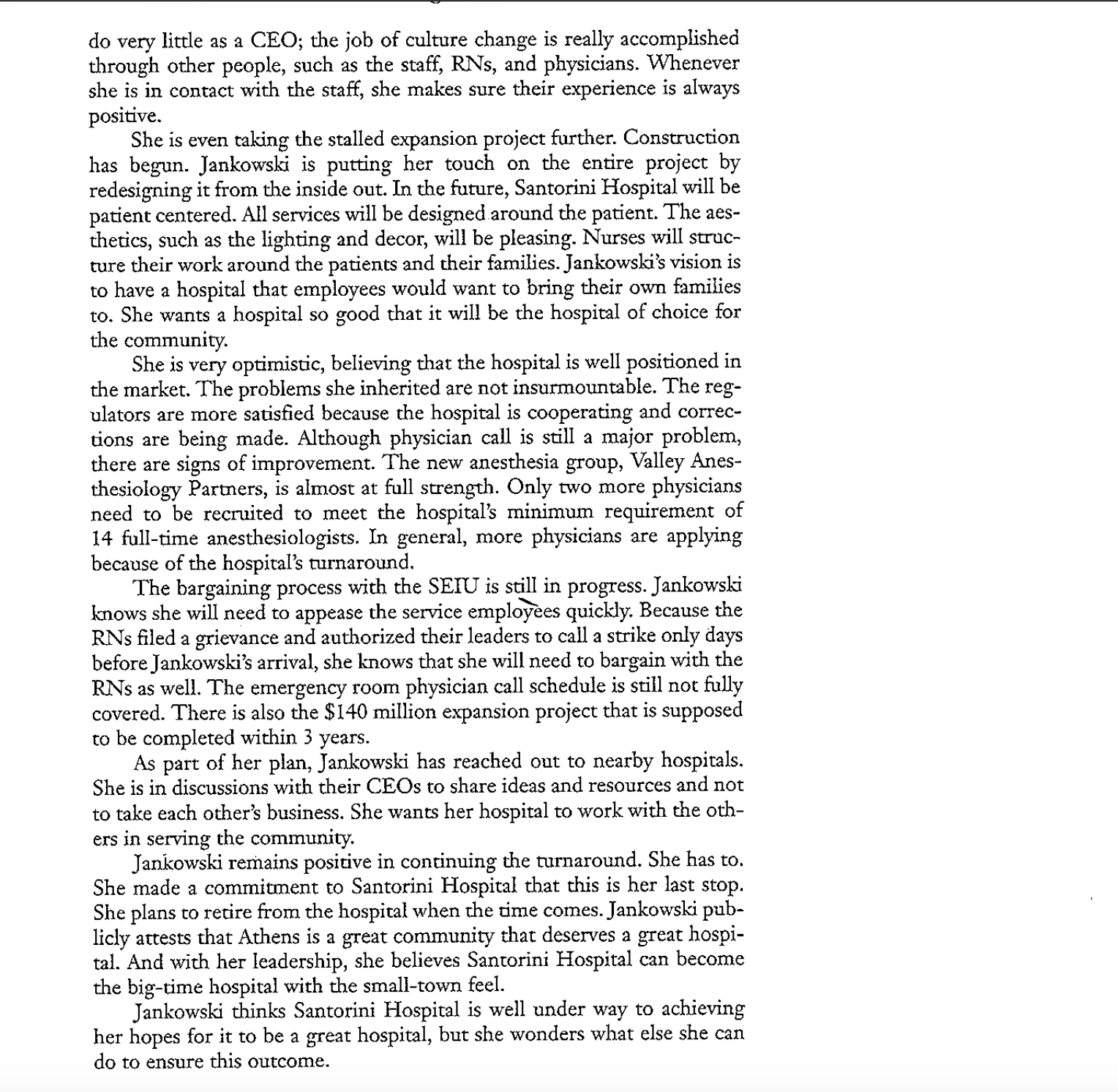- Nancy Jankowski began to initiate transformation change at Santorini Hospital by implementing a"self-learning model". How does this approach differ from the Scientific Management School of thought?
- how can Nancy Jankowski ensure that the implementation of the model will be successful? Support you answer with theory and examples from the case
Can Culture Change Save It? Ronnie Rodrigo Boongaling North Valley Dermatology Center, Chico, California Robert C. Myrtle University of Southern California, Los Angeles, California THE NEW JOB It is January 5, 2007, Nancy Jankowski's first day on the job as Santorini Hospital's new chief executive officer (CEO). She arrives to a hospital full of turmoil. Her predecessor, Alex Roth, who had before been the hospi- tal's chief operating officer (COO), resigned a few months earlier under intense pressure from the medical staff and the community. The interim CEO, Agnes Williams, halted the hospital's expansion project and laid off over 100 nonclinical staff. Physicians, nurses, and support staff were up in arms. The hospital was in the local headlines almost every day. THE HOSPITAL TODAY In 1913, Rene Santorini, M.D., performed the first operation in his new hospital in Athens, California. In 1937, Dr. Santorini moved the hospital This case is based on actual events. The organization, its location, and the names of peo- ple have been disguised. 355to its current downtown location. Today, Santorini Hospital is the center of the medical community in the city of Athens, a community of over 80,000 residents. It has 585 beds and a level 111 trauma center. Santorini Hospital is Athens's only hospital. In addition, the hospital's market share extends far beyond the city of Athens. The hospital serves over 500,000 residents in a sixcounty area. Athens is projected to have an annual population growth of 2%. The growth of the baby boom population will be higher than any other age group. Santorini Hospital is positioning itself for an increasing demand for services as well as for a changing composition of services. Also, because the current medical staff is aging, the hospital needs to attract new physicians to Athens. Many view the expansion project as quite important to Santorini Hospital's future. The project will cost $140 million and will add 201,000 square feet of additional hospital space, 150 new beds, 15 new operating rooms, and a new emergency department with 36 treatment bays. The construction has already started, with completion expected within 3 years. RECENT HISTORY In 2004, some of the nonclinical employees at Santorini Hospital (house- keeping, dietary, and service workers) voted for union representation in an effort to improve their situationlow wages, unaffordable health insur- ance, insufcient stafng levels, and no job security. Santorini's adminis- tration immediately objected to the election results and alleged that some of the ballots were incorrect. The union, Service Employees Intemational Union (SEIU), in conjunction with a wellknown professor from Athens State University, validated the employees' grievances with a study showing how Santorini contributes to the growth of Athens's working poor. The SElU study revealed that 1 out of 10 employees earned less than $8.00 per hour and 1 out of 4 employees earned less than $10.00 per hour. The median hourly wage was $11.96 per hour. Compared to similar hos- pitals near Athens, an entry-level housekeeper earned $12.77 per hour, while that same entrylevel position paid $7.50 at Santorini. An entry-level certied nursing assistant would have been paid $13.74 per hour at a nearby hospital compared to $9.66 at Santorini. In addition, fulltime employees at Santorini Hospital paid between $1,020 and $2,400 annually for their dependent health insurance, while the nearby hospital paid entirely for dependent coverage. The study pointed out that the hospital's \"substandard\" wages and inadequate benets caused serious nancial hardship to employees, who often had to do without healthcare because of high cost. Finally, the study concluded that the hospital was contributing ._.._.-_ .. .._. , _,__.____._. _.. . - 4.- ..._. ... . 6|1 to the burden on taxpayers because its service employees were using vari- ous government programs to supplement their incomes and healthcare. Despite the negative publicity, Santorini's administration proceeded with its objection to the formation of the union. In a hearing in Athens, an administrative law judge ruled that the election was valid. The hospital appealed the judge's decision to the National Labor Relations Board (NLRB). The NLRB upheld the judge's ruling and ordered Santorini Hospital to bargain with the union, but the administration still refused and sent a letter to the NLRB giving reasons why it refused to comply. The union wrote to the NLRB about the hospital's refusal. The NLRB declared that its decision for Santorini Hospital to bargain with the union was nal. Santorini led an appeal with an appeals court in Washington, DC. The hospital's attorney attested that if Santorini was not satised with the appeals court's decision, it would continue to le appeals to higher courts. Thus, Santorini Hospital did not bargain with the union. THE FIRE SPREADS The discontent with the service employees was a catalyst for more unrest in other parts of the hospital. A housekeeper on his own time decided to take cell phone video of overowing trash bins and medical waste at the hospital. His intent was to show that there were not enough employees to keep the hospital clean. Upon learning of this video, the hospital sus- pended the employee and then eventually red him for tardiness. The union cried foul, asserting that Santorini retaliated against an employee who was concerned about safety. The union formally sent a complaint to the Occupational Safety and Health Administration (OSHA) about the hospital's practice of not properly disposing of its medical wastes by letting the waste overow from trash containers. Santorini Hospital's repumtion in the community was diminishing. More and more articles were being written documenting the conict between the hospital and the union. Santorini Hospital was now front and center in the local newspapers. One article characterized it as a bully and implored the hospital to bargain. The voices of the union members were heard publicly when the members held a rally in front of the hospi tal asking Santorini's administration to bargain. The California Nurses' Association, the Athens Teachers' Association, and the California Faculty Association of Athens State University joined the union members' rally. Santorini still stood by is position of not bargaining. In addition, the hos- pital claimed that it had the support of a separate group of service employees, the secretaries and business ofce workers, who refused to join the SEIU. The union fought back. It took aim at Santorini's expansion project. AAG had a conflict of interest. AAG had agreed to have Dr. Ricardo Members were at every public meeting and filed objections to the envi- Marist as the negotiator because of his clinical background, but AAG later ronmental impact of the expansion. Objections often led to more meetings found that Marist was also consulting for the hospital on other matters. In and studies, which delayed the completion of the project. Each month's addition, one of the governance changes involved firing certain physicians delay cost between $500,000 and $1 million. from AAG, one of whom was Dr. Cris, and imposing a "gag order" against Residents near Santorini Hospital also joined the union, citing not any criticisms about Santorini's administration. Dr. Cris was known to be only environmental issues, but also quality-of-life impacts from the difficult with the nurses and staff increased automobile traffic and helicopter noise. The Athens City Four physicians at AAG quit and found employment outside Athens. Council ordered the hospital to conduct a more thorough environmental AAG gave the hospital notice that in a few days its remaining members study, adding more delay and project cost. The union also picketed on would no longer service Santorini Hospital's patients. This announcement other sites, such as the office of the vice chair of the board of trustees. sent a shockwave to the community. Shortly thereafter a retired orthope- dic surgeon, Dr. Frederick Thompson, placed a full-page advertisement in the local newspaper calling attention to the loss of the four AAG physi- CLINICAL INVOLVEMENT cians and questioning the capability of hospital management and the qual- ity of care at the hospital. Thompson's ad called the anesthesiologists the What started as a dispute with the service workers spread to the clinical "poor boys" compared to other physicians on call, such as the neurosur- sections of the hospital. Less than 2 years after the service workers voted geons. At the same time, Thompson built a Web site for medical person- to form a union, the registered nurses gave the leaders of their union the nel to give their vote of confidence to Santorini's administration and to power to call a strike. The nurses' issues involved health benefits for make comments. Athens residents were very concerned that the long- retired nurses, the ability of union leaders to enter the hospital and com- trusted anesthesiology group was no longer part of the community. Again, municate with nurses, and the practice of "floating," when nurses are Santorini Hospital was negatively in the headlines. assigned to departments in which they normally do not work. Santorini Hospital now had two labor problems to contend with-the service employees and the RNs. And there was more trouble on the way. THE VOTE PHYSICIAN INVOLVEMENT The chief of the medical staff, Dr. Felix Jovi, called a special meeting exclusively for the physicians at Santorini Hospital. The current president of AAG, Dr. Donald Foley, gave his account of the events leading to his Emergency call has never been a popular subject with hospitals and phy- group's decision to terminate its relationship with the hospital. In his sicians, and Santorini Hospital and its physicians are no exception. Last- remarks, Dr. Foley did not mention that AAG asked for double the money ing more than a year, recent contract negotiations with the Athens even though they already had a contract in principle of $850,000 with Anesthesiology Group (AAG) led to an agreement in principle. The con- Santorini Hospital. One of the board members, a physician, explained to tract called for certain governance changes at AAG that the hospital the medical staff that taking call was not only a problem for the anesthesi- claimed would increase efficiency. In addition, AAG would receive ologists, but also for the entire medical staff. He emphasized that physi- $850,000 for signing an exclusive contract with the hospital. A few weeks cians do not want to take call, even though the emergency room desper- thereafter, AAG increased its demand to $1.4 million, and then upped the ately needs their services. He also added that Santorini's administration ante to $1.7 million. Alex Roth, the CEO at the time, claimed that the hos- did not have enough time to consult with the medical staff about con- pital could not meet the demand, so an alternative solution was sought. tracting with another anesthesia group because AAG gave only a few days' Santorini's administration decided to contract with a new anesthesiology notice before it decided to terminate its relationship. At that point, group headed by a former member of AAG, Dr. Mercedes Celia. Dr. Jovi interceded. He wanted to focus on the administration's failure to AAG protested, claiming that the governance changes were designed consult with the medical staff before a new group was hired. to prevent its members from criticizing the hospital's administration. Dr. Cris, the physician who purportedly was asked to leave AAG as a Dr. Bruno Cris, AAG's former president, also claimed that the third-party condition of the contract, enlivened the discussion further when he pro- ought in to broker a deal betwee San orini Hospital and duced a secretly recorded conversation supposedly implicating his formercolleague, Dr. Celia, of taking sides with Santorini Hospital. Dr. Cris Other physicians also left the call schedule. Five months after AAG alleged that Dr. Celia was ordered by then-CEO Roth to spy on him by left, the orthopedic group left the hospital. That same month, a prominent driving by his house to check if there was a pro-union sign on his front vascular surgeon left the call schedule. The cardiac surgeon that Santorini yard. Dr. Celia, without hearing the tape, gave consent for it to be played. Hospital relied on for its cardiovascular center of excellence left the hos- The audiotape did not reveal any such order from Roth, and the stage had pital and took his entire cardiac surgery team with him. Trauma surgeons been set to steer the discussions away from AAG to Roth exclusively. radiation oncologists, a hospitalist, a psychiatrist, an interventional cardi- Dr. Cris argued vigorously that Roth was the cause of all of the hospital's ologist, and two radiologists also left the hospital. With the exodus of problems. Most of the discussion in the meeting had to do with Roth being physicians and nurses, a local newspaper labeled Santorini Hospital a dan- dictatorial and vindictive. Some accused him of using "security" as the gerous place. reason for placing cameras in the hospital as a cover for spying on the staff. The physicians overwhelmingly gave Roth a vote of no confidence. A NEW SKIPPER AT THE HELM A SHAKEUP LOOMS Santorini Hospital's board of trustees selected Nancy Jankowski as the new CEO in January 2007. She brought 25 years of executive management The vote of no confidence was published in the local newspapers and became experience with her. Her tenure at her last hospital, Florence Adventist the topic of conversation in Athens. Roth did not comment on the vote and Hospital in Maryland, was a testament to her leadership abilities. Prior to concentrated on the loss of AAG. The Santorini Hospital started prioritizing Jankowski's reign there, Florence's administration also received a vote of its surgery schedule. It hired some anesthesiologists from nearby hospitals no confidence. Unlike Santorini, Florence Adventist Hospital was about to and employed locum tenens as well. This gave Dr. Celia time to recruit new lose its accreditation when Jankowski took over. She guided Florence from physicians to Roth's newly formed group, Valley Anesthesiology Partners. the brink of collapse to being an award-winning hospital. In addition, the While Roth tried to manage the anesthesiology crisis at Santorini fact that Jankowski was an RN brought her instant credibili edibility with Hospital, he could not stop the momentum that the service employees had Santorini's nurses and physicians. Jankowski considers herself an "acciden started, culminating in the no-confidence vote by the physicians. After tal CEO." She readily admits that she did not have formal training to extensive coverage in the media, Roth announced his retirement, his last day become an executive, but she always had a passion for patient care. being the end of the month. The board of trustees announced an immedia Healthcare professionals at Santorini Hospital received the news of ate search for his replacement. With Roth's departure, half of the board Jankowski's selection with guarded optimism. Their agenda included let- members, including the chair and the vice chair, also announced their resig- ting the new CEO know of their concerns, such as lack of openness and nations. Santorini Hospital was experiencing a broad changing of the guard. transparency. SEIU wanted, at last, to bargain with the hospital's adminis- Interim CEO, Agnes Williams, was brought in while the hospital tration. The physicians wanted the hospital's leaders to repair their dam- recruited its next CEO. Williams was known for coming into troubled hos- aged relationship. Everyone wanted a change in the style of management. pitals. In her short stay at Santorini Hospital, she determined that the facil- When Jankowski arrived, she announced that her primary focus was to ity was in financial trouble, so she announced the layoff of 5% of its work- change the hospital culture. She set about this task immediately. force. This included the same secretaries and business office employees who had refused to join the SEIU. In addition, she questioned the value of the expansion project and halted actions leading to ground breaking. EARLY STEPS IN CHANGING THE CULTURE The issue of not having enough anesthesiologists was still in full swing. Recent patient deaths at Santorini Hospital were prominently covered in Even before her arrival, Jankowski ordered a focused review of the surgery the local newspapers. The sheriff's department got involved in the investi- and anesthesiology departments. She was establishing a proactive gations of three deaths, one of which had a clear connection to anesthesiol- approach to managing the hospital and sought to identify issues before ogy. The sheriff's department wanted to determine if the hospital's anesthe- they became problems. The first action Jankowski took after she arrived siology department posed a danger to the public. Several local physicians was to reinstate the laid-off service employees, who also received back pay alleged that Santorini Hospital was supporting the practice of dangerous for the period of their layoff. She recognized the SEIU union, 3 years after the service employees had voted for it. On May 22, 2007, bargaining talksbetween SEIU and Santorini's administration commenced. Subsequent weekly talks and the content of those meetings were published on the hos- pital Web site, a rst for Santorini Hospital. On her rst days at Santorini Hospital, Jankowski focused on culture change through increased transparency. Communication with employees and the medical staff improved considerably following her arrival. Together with her management team, Jankowski began sending weekly messages on a general voicemail about what was going on in the hospital. Employees and the medical staff could call this voicemail box anytime and listen to her CEO report. Jankowski wanted to let the employees know that messages she left for them through her voicemails were not just her interpretations; they included feedback from all of the managers. She also wanted to put a voice to her name because she recognized that most of the employees had never met her. She also invited the physicians to a get-to-knowyou meeting during which she jokingly told them that they were only allowed one vote of no condence in their lifetimes. Jankowski also began communicating signif icant news about the hospital to the medical staff via fax. THE REGULATORS: A NEW COMPLICATION FOR JANKOWSKI Days before Jankowslti's arrival, the State Department of Health Services (DHS) sent a nurse to inspect Santorini Hospital in connection with the ' death in February of a 44year-old patient, who had been in the hospital for elective shoulder surgery. The inspector reported her ndings to the Centers of Medicare and Medicaid Services, which subsequently asked DHS to do a follow-up inspection. On April 3, 2007, the original DHS inspecting nurse as well as a physician carried out a more extensive 5-day survey of the hospital. In the past, the staff had resisted such surveys. Jankowski emphasized to them that the surveyors were there to help the hospital identify and x problems. She also expressed that she wanted to change the culture of ignoring problems and ghting those who pointed out problems, as the surveyors had been asked to do. After their inspection, the surveyors told Jankowskj that their experience was more positive than in the past. Jankowski in-unediately put into place corrective actions. This process, however, was for a time interrupted when Jankowski was injured in an accident during a family trip and could not return to work for a few weeks. During her absence, 2 team of 10 DHS inspectors arrived to conduct another top-down inspection of the hospital. The survey was unannounced and the surveyors found deciencies in seven areas, although they were mostly administrative in nature. [The surveyors reported that many of the deciencies found in the April survey had already been corrected and that no problems jeopardized patient care or safety. True to her commitment of transparency, Jankowski published the results of the follow-up survey. In October 2007, the California Department of Public Health ned Santorini Hospital $50,000 for inadequately monitoring a drug that cases nausea but has dangerous side effects. Jankowski knew that inspections became more frequent when negative publicity and adverse events oc curred; however, she was condent that the organization would be better prepared for the next survey. JANKOWSKI BEGINS TO CHANGE SANTORINI'S CULTURE Jankowski remains committed to culture change at Santorini Hospital. .In addition to being more transparent, she is encouraging accountability within the organization. She expects the staff to follow policies and proce- dures and holds her senior management team accountable for their per- formance. Her CEO report is the same report that is presented to the board of trustees as well as to the staff. She holds her management team accountable for the contents of the report. Jankowski is transforming the management of Santorini into a \"self- leaxning\" model. She began by assessing the talent level of all senior man agers. Those who could not lead by engaging the staff were let go. Thus, many of the senior managers have taken on added responsibihties until suitable middle managers are found. The self-learning model begins at the top, with senior managers adopting the new management style rst. They then teach it to their middle managers, who will in turn teach it to the supervisors, until all employees and medical staff become accustomed to selfmanaging. Jankowski knows that this management style will not work for all departments at the hospital. She knows that there are different mlent levels; this style requires a more sophisu'cated manager. She also understands that this type of leadership will thrive in certain departmens, such as the emer- gency department, but may not work well in others, such as food semce. Jankowski has lofty goals, but knows that the self-learning model might turn - out to be a hybrid of selfmanagement and regimented management GOING FORWARD Jankowski is strongly committed to changing the former culture of not being accountable, nding blame, and not collaborating at Santormi Hospital. She believu it sou-ts with her. She publicly acknowledges she can do very little as a CEO; the job of culture change is really accomplished through Other people, such as the staff, RNs, and physicians. Whenever she is in contact with the staff, she makes sure their experience is always positive. She is even taking the smlled expansion project further. Construction has begun. Jankowski is putting her touch on the entire project by redesigning it from the inside out. In the future, Santorini Hospital will be patient centered. All services will be designedaround the patient. The aes- thetics, such as the lighting and decor, will be pleasing. Nurses will struc ture their work around the patients and their familiesJankOWSki's vision is to have a hospital that employees would want to bring their own amilies to. She wants a hospital so good that it will be the hospital of choice for the community. She is very optimistic, believing that the hospital is well positioned in the market. The problems she inherited are not insurmountable. The reg- ulators are more satised because the hosPiml is cooperating and correc- tions are being made. Although physician call is still a major problem, there are signs of improvement. The new anesthesia group, Valley Anes thesiology Partners, is almost at full strength. Only two more physicians need to be recruited to meet the hospital's minimum requirement of 14 fulltime anesthesiologists. In general, more physicians are applying because of the hospital's turnaround. The bargaining process with the SEIU is still in progress. Jankowslti knows she will need to appease the service emplo'yEes quickly. Because the ENS led a grievance and authorized their leaders to call a strike only days beforeJankowslti's arrival, she knows that she will need to bargain with the RNs as well. The emergency room physician call schedule is still not fully covered. There is also the $140 million expansion project that is supposed to be completed within 3 years. As part of her plan, Jankowski has reached out to nearby hospitals. She is in discussions with their CEOs to share ideas and resources and not to take each other's business. She wants her hospital to work with the oth- ers in serving the community. Jankowski remains positive in continuing the turnaround. She has to. She made a commitment to Santorini Hospital that this is her last stop. She plans to retire from the hospital when the time comes._]anlcowsld pub- licly attests that Athens is a great community that deserves a great hospi- tal. And with her leadership, she believes Santorini Hospital can become the big-time hospital with the small-town feel. Jankowski thinks Santorini Hospiuil is well under way to achieving her hopes for it to be a great hospital, but she wonders what else she can do to ensure this outcome
